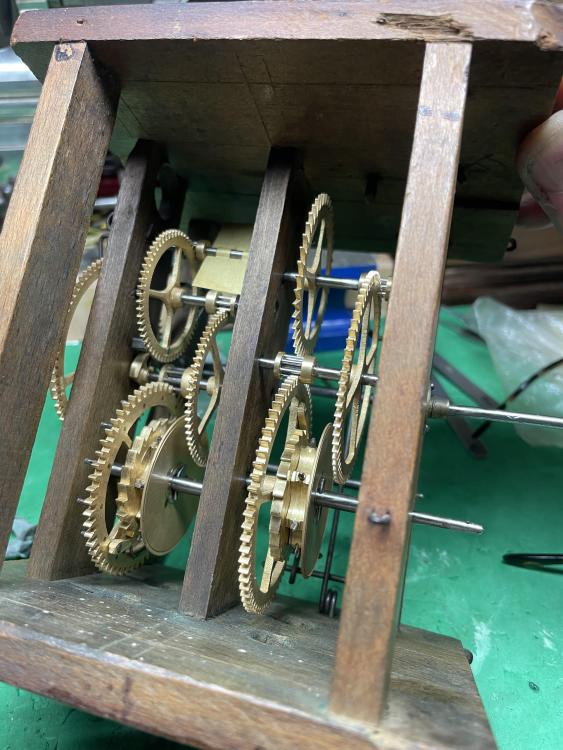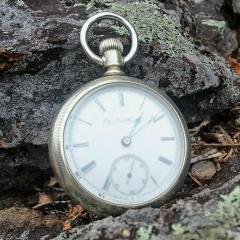Leaderboard
Popular Content
Showing content with the highest reputation on 10/02/22 in Posts
-
This one would be a challenge for a highly skilled watchmaker with lots of hairspring experience, and very well could be impossible to get "perfect" for even the best hairspring person. But as others have said, it's well worth some time to see how much better you can make it. Just a couple of tips- Check what kind of correction you want to make, it will basically fall into two categories: correction in the round, and correction in the flat. Generally the correction is made at one place for a given error- though that can be a bit fluid with a spring so mangled. -for a correction in the round, find the point of maximum error, go back (follow the spring toward the center) 90 degrees and make the correction. -for a correction in the flat, find the point of maximum error, go back 180 degrees and make the correction.3 points
-
Ok, another attempt at 3D printing in ABS plastic. Did more work and design to keep it from warping off the build plate. There was still a tiny bit of warping, but overall ended up much flatter. Also used a brass threaded insert melted in the side for the setscrew. Overall, the results seem very good. I'll have to run it thru a few cycles to see how the ABS holds up in my solutions. I'm using the Non-ammoniated Zenith solution followed by distilled water then 99% IPA. The basket still works best in 1 of the 3 orientations. I was thinking of designing a 3D printed basket to remove that variable as well.2 points
-
if you believe the manufacture the watch doesn't need to be serviced for a few more years there claiming it doesn't have to go back for servicing until 2030. https://www.oris.ch/movement/72/CALIBRE 400 always interesting to read the technical points on the manufacturers webpage I wonder if this watch really will run for 10 years?1 point
-
If it's not in beat, watches need a shake to start. As long as it's keeping time and has the 5 day reserve, I wouldn't worry about it.1 point
-
If after winding 215 times AND giving it a "jump start" does the watch keep time for 5 days without stopping or slowing again? It's possible that the watch simply needs to be cleaned and re-lubricated.1 point
-
These guys can probably help: https://midwest-clock-repair.myshopify.com/products/schatz-repair-rebuild-service-for-schatz-royal-mariner-ships-bell-clock-movement These guys specifically have a listing for the glass (but you'll need to know the diameter in mm): https://www.sheridanmarine.com/product/replacement-royal-mariner-clock-glass £13.30 for 84mm up to £20.95 for 146mm.1 point
-
A simple multimeter would get you some testing. A resistance test on the coils would be possible. Breaks in the coils may not be easy to see with a loupe. If you are wanting to get more into watch repair a microscope is invaluable. You have resistance testing on this. The ohms meter. Just a thought for a simple fault check. All quartz watches that i have disconnect the battery when the crown is pulled, I'm fairly sure rhis applies to most battery watches. Called a hacking feature on mechanical watches that halt the second hand. You have resistance testing on this. The ohms meter. Just a thought for a simple fault check. All quartz watches that i have disconnect the battery when the crown is pulled, I'm fairly sure rhis applies to most battery watches. Called a hacking feature on mechanical watches that halt the second hand. The probes ends on this as with most multimeters will be too large for the small contact circuit points of a quartz movement. I attached a fine needle to each of the probes to make testing easier and more accurate.1 point
-
The Watch Repairer's Manual by Henry B. Fried ISBN: 978-1-68422-220-91 point
-
I think you should remove the rechargeable battery and put in a similar sized silver oxide cell just to make sure that the movement is working. Then you could test if the rechargeable battery has any charge in it. Use a normal multimeter set to 2V range and see if there is any voltage. The you could try charging the battery by connecting a 1.5V battery across the terminals. Leave it to charge overnight. If by morning there is 1.5V across the battery, then the battery is ok. Then by elimination, the fault is in the charging circuitry.1 point
-
Sorry but highly unlikely to achieve success with this one.. Well worth an attempt thou to just fine tune your skills1 point
-
I'm assuming your question is regarding the fact that the arms of the balance rim are not true anymore? The repair is done once the new staff has been rivetted and the roller fitted. The balance is held by its staff in a set of truing calipers, and then the rim is literally bent back in to true. There are good descriptions of the process in standard books like Fried's Watchmaker's Manual, and perhaps other members have links to online resources.1 point
-
as it's disposable and this is watch repair learning group then by all means six they hairspring. Because the only way to get good at fixing hairsprings is fixing hairsprings. It just isn't good the practice on something that cannot be replaced1 point
-
Like I said, I use Zenith Non Ammoniated solution. Mostly cause its concentrated 8 to 1 mix with water so I get a lot of bang per buck and its easy to dispose of. I've only used it a couple times so still learning it. The first time I ever used it there were no bubbles. The second time I think I was going to fast and there was a lot of foam. Both of those were with the stock basket and rotor. With the redesigned rotor there was a tiny bit of foam, but I think that was mostly because I started it to fast. Once I got the speed at a nice slow pace it was running great. Some people say that used Zenith solution can gel up after a few days if you don't use it because of the bacteria that can grow in it. I haven't experienced that yet, and I've had the used solution sitting around for a couple weeks now. In the water and IPA there was no issues with bubble/foaming even when spinning pretty quickly. I'll try to grab a video tomorrow.1 point
-
I can easily find a replacement hairspring or balance complete, or donor movement. It's an AS 1240 from an unremarkable Banner watch. I paid about $3 for it so I don't need to fix it, nor is I worth $15 on a hairspring or $25 for a balance complete. Skill building though.1 point
-
Perhaps a combination of broken lower jewel and really worn lower pivot would cause the entire escape wheel to sit too low.1 point
-
I have one of these on the wall, Its problem is the hand drive. It uses a ruberised compound in the center of the hour wheel which has shrunk a bit and will not drive the hands correctly so will have to think of some way to resurect the material or replace it with a rubber bush. As its mine its in the que to be done1 point
-
1 point
-
It might be interesting to hear that Dr. Roland Ranfft as a watch enthusiast and creator of the worlds greatest watch caliber datebase claims to successfully use just three lubricants for watch services: a thick oil, a thin oil and a PTFE grease. All are synthetics! He uses the PTFE grease for barrel walls of automatics also.1 point
-
I suppose my last comment did sound a bit optimistic (Friday night, who can blame me). Up to a point, you do get what you pay for. I myself have unintentionally been bitten from a poorly chosen lubricant. (Anchor clock oil) it wasn't chosen for price rather for convenience. As has been noted above, quality, precious, sentimental and those belonging to others should wait for your skills and backing to improve. In my situation, everything involved was all my own and the cost of my experience was mostly just my time and frustration. Everything I used Anchor clock oil on now needs to be disassembled and cleaned again. Some of us are unfortunately doomed to learn from our own failures. If you are willing to chalk any loss up to your learning and experience, have at. As they say, "Investment involves the risk of loss". Everyone, have a great weekend. Shane1 point
-
1 point










